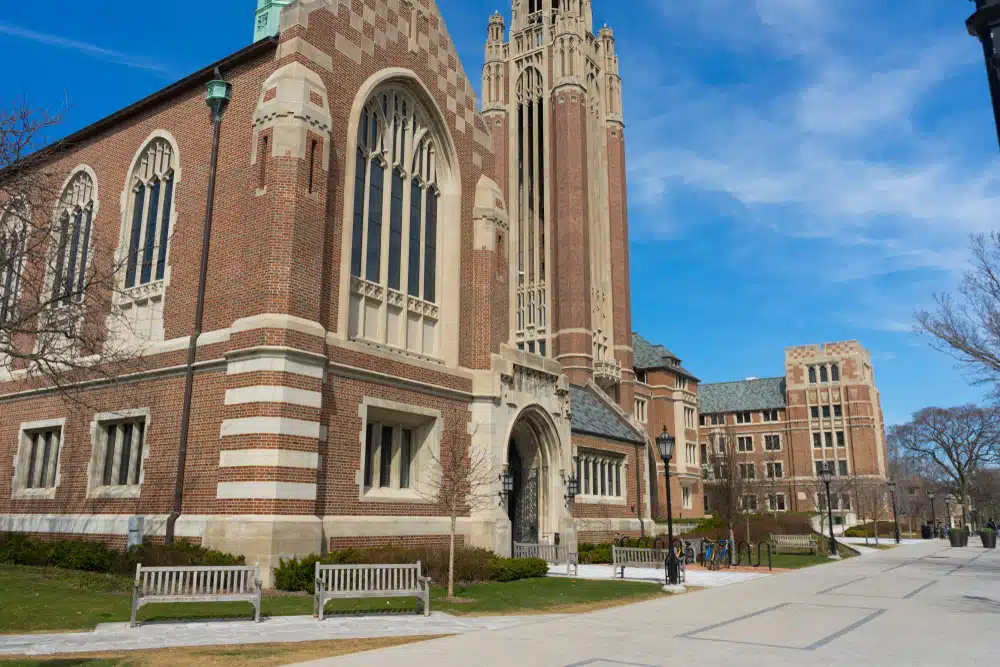College courses tackle big questions through research – University of Chicago News

University of Chicago Research-Based Courses Advance Sustainable Development Goals
A report on two research-based courses at the University of Chicago highlights a pedagogical model that directly engages students in projects contributing to the United Nations Sustainable Development Goals (SDGs). The courses, “Biomechanics: How Life Works” and “Social Science Inquiry,” provide students with hands-on research experience, enabling them to generate original knowledge aligned with global sustainability targets.
Biomechanics Research: Supporting Life on Land and Below Water (SDG 14 & 15)
The “Biomechanics: How Life Works” course, led by Professor Mark Westneat, immerses students in original research to understand how organisms interact with physical forces. This inquiry-based learning model fosters contributions to several SDGs, primarily through the advancement of scientific knowledge and education.
Course Structure and Alignment with SDG 4: Quality Education
The course is structured to transition students from foundational learning to independent research, embodying the principles of SDG 4 (Quality Education) by providing inclusive and equitable quality education and promoting lifelong learning opportunities.
- Foundational Knowledge: Initial lectures and practice labs equip students with essential skills in biomechanical research.
- Technical Proficiency: Students gain experience with advanced laboratory equipment, including tensometers, high-speed cameras, and flow tanks.
- Independent Research: The latter part of the course is dedicated to student-led projects, where they function as primary researchers with faculty mentorship.
- Knowledge Dissemination: Students conclude the course by presenting their findings in a research paper and a formal presentation, contributing to the scientific community.
Student Projects and Contributions to Biodiversity Goals
Student-led research projects focus on the functional mechanics of various species, generating data that supports the understanding and conservation of biodiversity, a core component of SDG 14 (Life Below Water) and SDG 15 (Life on Land).
- Insect Biomechanics: An experiment measuring the pulling force of a cockroach provides insights into the functional capabilities of terrestrial invertebrates, relevant to SDG 15.
- Avian and Lepidopteran Flight: Research on the flexibility and strength of bird feathers and butterfly wings contributes to the understanding of animal locomotion and material science, which has implications for both biodiversity studies (SDG 15) and bio-inspired innovation (SDG 9: Industry, Innovation, and Infrastructure).
- Aquatic Locomotion: Studies on the pectoral fins of fish provide data on aquatic biomechanics, directly supporting the knowledge base for SDG 14.
Social Science Inquiry: Strengthening Institutions and Climate Action (SDG 13 & 16)
Professor Andy Eggers’ “Social Science Inquiry” course utilizes a collaborative research group model to address pressing societal issues. The course structure empowers students to collectively design, execute, and report on a single, in-depth research project, directly engaging with SDGs related to governance and environmental policy.
Collaborative Research Model and SDG 16: Peace, Justice, and Strong Institutions
The course’s focus on analyzing public opinion on electoral systems, such as ranked-choice voting, is a direct contribution to SDG 16, which aims to build effective, accountable, and inclusive institutions at all levels. By investigating voter comprehension and satisfaction, the research seeks to inform improvements in democratic processes.
Research Process:
- Literature Review: Students begin by analyzing existing research to identify knowledge gaps.
- Collaborative Design: Through class discussions, a central research question is developed and refined. For instance, the class identified a gap in understanding how voter comprehension of ranked-choice voting affects its public perception.
- Survey Implementation: Students design and launch a survey to gather empirical data on the chosen topic.
- Co-authored Publication: The findings are synthesized into a co-authored research paper intended for submission to a peer-reviewed journal, ensuring the knowledge contributes to the broader academic and policy conversation.
Addressing Climate Change through Public Opinion Research (SDG 13)
A previous iteration of the course focused on public opinion regarding climate change. This research directly supports SDG 13 (Climate Action) by providing critical data on public attitudes and perceptions, which is essential for developing and implementing effective climate policies and public awareness campaigns. The course methodology demonstrates how social science research can be a vital tool for addressing the global climate crisis.
Analysis of Sustainable Development Goals in the Article
1. Which SDGs are addressed or connected to the issues highlighted in the article?
-
SDG 4: Quality Education
The entire article focuses on transformative, research-based courses at the University of Chicago. It highlights hands-on learning, development of advanced research skills, and opportunities for students to conduct original research and contribute new knowledge, which are all hallmarks of quality higher education.
-
SDG 13: Climate Action
The article explicitly mentions that a “Social Science Inquiry” course focused on the broad theme of “public opinion about climate change,” directly connecting the educational activities to a critical aspect of climate action—understanding public awareness and attitudes.
-
SDG 14: Life Below Water
The “Biomechanics: How Life Works” course involves research on aquatic life. The article mentions students study “how fish swim,” use “flow tanks” described as “treadmills for fish,” and a student’s thesis examined the “pectoral fins of fish.” This contributes to the scientific understanding of marine and aquatic biodiversity.
-
SDG 15: Life on Land
The biomechanics course also heavily features research on terrestrial animals. The article details student projects and lab work involving butterflies, cockroaches, and birds, contributing to the scientific knowledge base about life on land.
-
SDG 16: Peace, Justice and Strong Institutions
The “Social Science Inquiry” course is described as analyzing “public opinion about ranked-choice voting.” This research investigates the functioning and public perception of electoral systems, which are fundamental components of effective and accountable institutions.
2. What specific targets under those SDGs can be identified based on the article’s content?
-
Target 4.4: By 2030, substantially increase the number of youth and adults who have relevant skills, including technical and vocational skills, for employment, decent jobs and entrepreneurship.
- The courses provide students with advanced, practical research skills. For example, students in the biomechanics lab learn to “measure force with a tensometer, capture video with high-speed cameras and use flow tanks.” Students in the social science course learn to “design and use a survey” and analyze data. These are relevant skills for careers in science and research.
-
Target 13.3: Improve education, awareness-raising and human and institutional capacity on climate change mitigation, adaptation, impact reduction and early warning.
- The social science course, by choosing “public opinion about climate change” as its research theme, directly engages in improving education and building the capacity of students to understand and research this critical issue.
-
Target 14.a: Increase scientific knowledge, develop research capacity and transfer marine technology… in order to improve ocean health and to enhance the contribution of marine biodiversity to the development of developing countries.
- The research on “how fish swim” and the “phenotypic plasticity of the pectoral fins of fish” directly contributes to increasing “scientific knowledge.” The course structure itself is designed to “develop research capacity” among undergraduate students.
-
Target 15.5: Take urgent and significant action to reduce the degradation of natural habitats, halt the loss of biodiversity and, by 2020, protect and prevent the extinction of threatened species.
- While not taking direct conservation action, the fundamental research described in the article—such as studying the flexibility of butterfly wings, the force a cockroach can pull, and the strength of bird feathers—is essential for understanding biodiversity. This knowledge is a prerequisite for developing effective conservation strategies.
-
Target 16.6: Develop effective, accountable and transparent institutions at all levels.
- The research into “ranked-choice voting” and why it might lead to “voter dissatisfaction” is a direct inquiry into the effectiveness of electoral institutions. The goal is to contribute knowledge that could inform the development of better systems.
3. Are there any indicators mentioned or implied in the article that can be used to measure progress towards the identified targets?
- Publication of research papers: The article explicitly states that students’ work leads to publications. Professor Westneat notes he has “had a couple of students go on to publish a paper,” and Professor Eggers plans to submit the class’s co-authored paper “for publication at a peer-reviewed journal.” This is a direct indicator of the creation and dissemination of new scientific knowledge (relevant to SDGs 4, 13, 14, 15, 16).
- Development of original research projects: The article emphasizes that students pursue their own research questions. The biomechanics course is based on “original research,” and social science students “design and execute projects.” The number and variety of these projects serve as an indicator of increased research capacity (relevant to SDG 4).
- Use of scientific methodologies and tools: The article mentions specific methods used to gather data. These include using a “tensometer” to measure force, “high-speed cameras” to record motion, and designing and deploying a “survey” to gauge public opinion. The application of these tools is an indicator of the level of technical skill being acquired by students (relevant to Target 4.4).
- Analysis of public opinion: The social science course’s method of analyzing “public opinion about ranked-choice voting” by testing whether a “lack of understanding… might be leading to voter dissatisfaction” is a specific method for measuring public perception of institutions (relevant to SDG 16).
4. Table of SDGs, Targets, and Indicators
| SDGs | Targets | Indicators |
|---|---|---|
| SDG 4: Quality Education | Target 4.4: Increase the number of youth and adults who have relevant skills for employment. |
|
| SDG 13: Climate Action | Target 13.3: Improve education, awareness-raising and human and institutional capacity on climate change. |
|
| SDG 14: Life Below Water | Target 14.a: Increase scientific knowledge and develop research capacity. |
|
| SDG 15: Life on Land | Target 15.5: Halt the loss of biodiversity. |
|
| SDG 16: Peace, Justice and Strong Institutions | Target 16.6: Develop effective, accountable and transparent institutions. |
|
Source: news.uchicago.edu

What is Your Reaction?
 Like
0
Like
0
 Dislike
0
Dislike
0
 Love
0
Love
0
 Funny
0
Funny
0
 Angry
0
Angry
0
 Sad
0
Sad
0
 Wow
0
Wow
0











































































